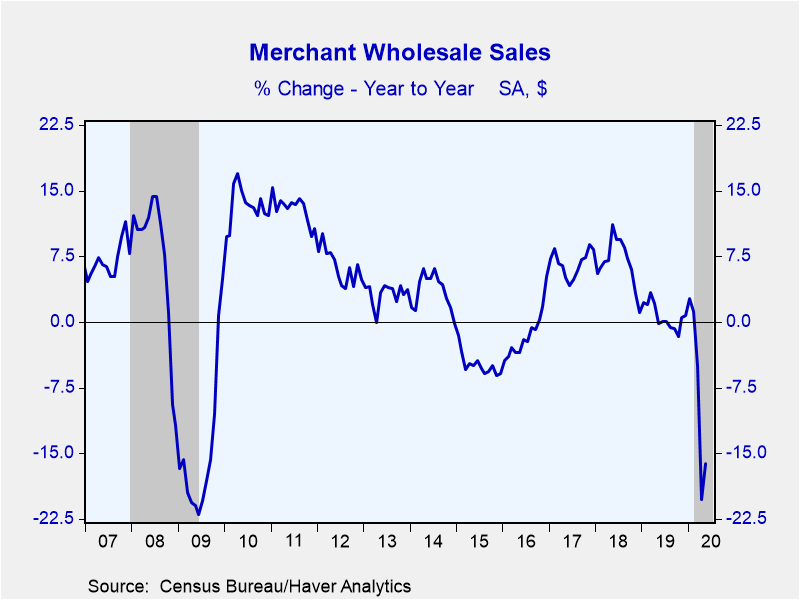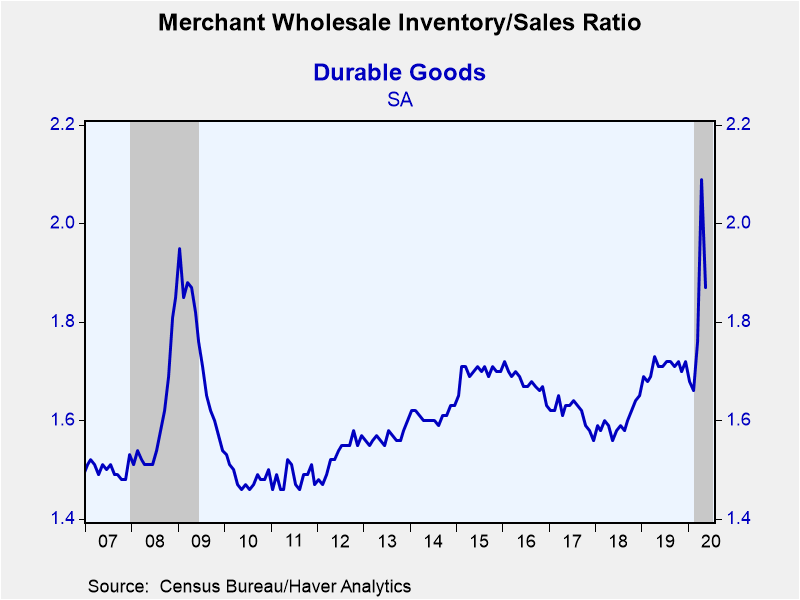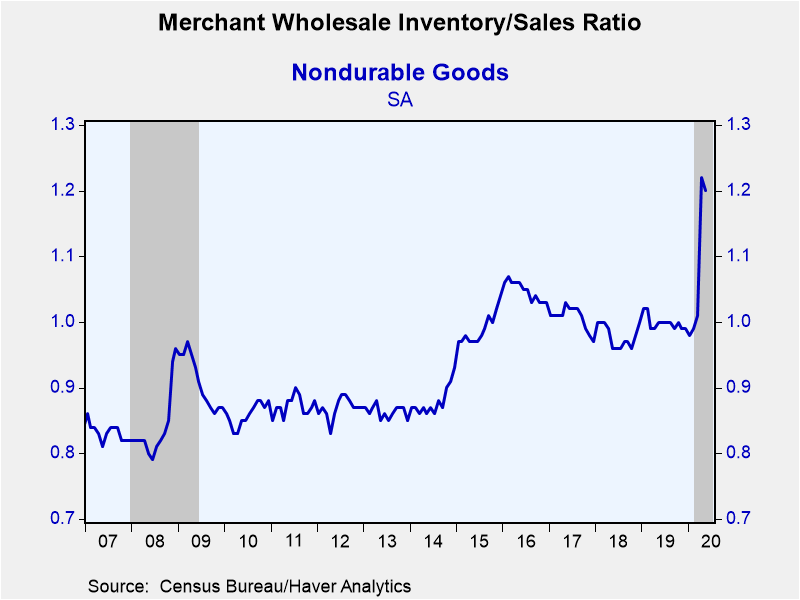 Global| Jul 09 2020
Global| Jul 09 2020U.S. Wholesale Inventories Fall as Sales Surge
by:Tom Moeller
|in:Economy in Brief
Summary
• Wholesale inventory decline is broad-based. • Sales spike is notable in durables sector • Inventory to sales ratio remains elevated. Wholesale inventories fell 1.2% (-4.2% y/y) as durable goods inventories slid 2.0% (-5.1% y/y). The [...]
• Wholesale inventory decline is broad-based.
• Sales spike is notable in durables sector
• Inventory to sales ratio remains elevated.
Wholesale inventories fell 1.2% (-4.2% y/y) as durable goods inventories slid 2.0% (-5.1% y/y). The decline was paced by a 5.1% decline (-10.5% y/y) in motor vehicles inventories. Machinery inventories also fell 2.3% (-3.1% y/y) and electrical goods inventories eased 0.1% (-5.3% y/y). Inventories of nondurable goods edged 0.1% higher (-2.8% y/y) as petroleum inventories strengthened 14.4% (-24.8% y/y) with the upturn in prices. Chemical inventories gained 1.3% (-6.6% y/y) and farm product inventories fell 1.8% (-15.4% y/y). The value of paper inventories declined 1.3% (+2.8% y/y).
Wholesale sales rebounded 5.4% (-16.2% y/y) following three straight months of significant declines. Sales of durable goods jumped 9.3% (-13.4% y/y) led by a 23.4% strengthening (-29.4% y/y) in motor vehicle sales. Sales of furniture gained 22.8% (-15.0% y/y) and professional & computer equipment sales improved 3.4% (-10.4% y/y). Sales of nondurable goods rose 1.8% (-18.8% y/y) as chemical sales increased 3.2% (-20.0% y/y). Apparel sales improved 44.5% but were off 47.7% y/y. Petroleum sales weakened 1.8% (-54.6% y/y).
The inventory-to-sales (I/S) ratio at the wholesale level fell to 1.53 in May after jumping to a record high of 1.63 in April (data begin in 1980). Both the durable goods (1.87) and non-durables (1.20) I/S ratios retraced pieces of the April upturns, but remained near record levels. The sector data extend back to 1992.
The wholesale trade figures, industrial production and oil prices are available in Haver's USECON database. The expectations figure for inventories is contained in the MMSAMER database. Expectations for sales are in the AS1REPNA database.
| Wholesale Sector - NAICS Classification (%) | May | Apr | Mar | May Y/Y | 2019 | 2018 | 2017 |
|---|---|---|---|---|---|---|---|
| Inventories | -1.2 | 0.2 | -1.1 | -4.2 | 1.7 | 6.5 | 3.0 |
| Sales | 5.4 | -16.4 | -5.1 | -16.2 | 0.6 | 6.8 | 6.7 |
| I/S Ratio | 1.53 | 1.63 | 1.36 | 1.34 (May '19) | 1.34 | 1.28 | 1.30 |
Tom Moeller
AuthorMore in Author Profile »Prior to joining Haver Analytics in 2000, Mr. Moeller worked as the Economist at Chancellor Capital Management from 1985 to 1999. There, he developed comprehensive economic forecasts and interpreted economic data for equity and fixed income portfolio managers. Also at Chancellor, Mr. Moeller worked as an equity analyst and was responsible for researching and rating companies in the economically sensitive automobile and housing industries for investment in Chancellor’s equity portfolio. Prior to joining Chancellor, Mr. Moeller was an Economist at Citibank from 1979 to 1984. He also analyzed pricing behavior in the metals industry for the Council on Wage and Price Stability in Washington, D.C. In 1999, Mr. Moeller received the award for most accurate forecast from the Forecasters' Club of New York. From 1990 to 1992 he was President of the New York Association for Business Economists. Mr. Moeller earned an M.B.A. in Finance from Fordham University, where he graduated in 1987. He holds a Bachelor of Arts in Economics from George Washington University.










